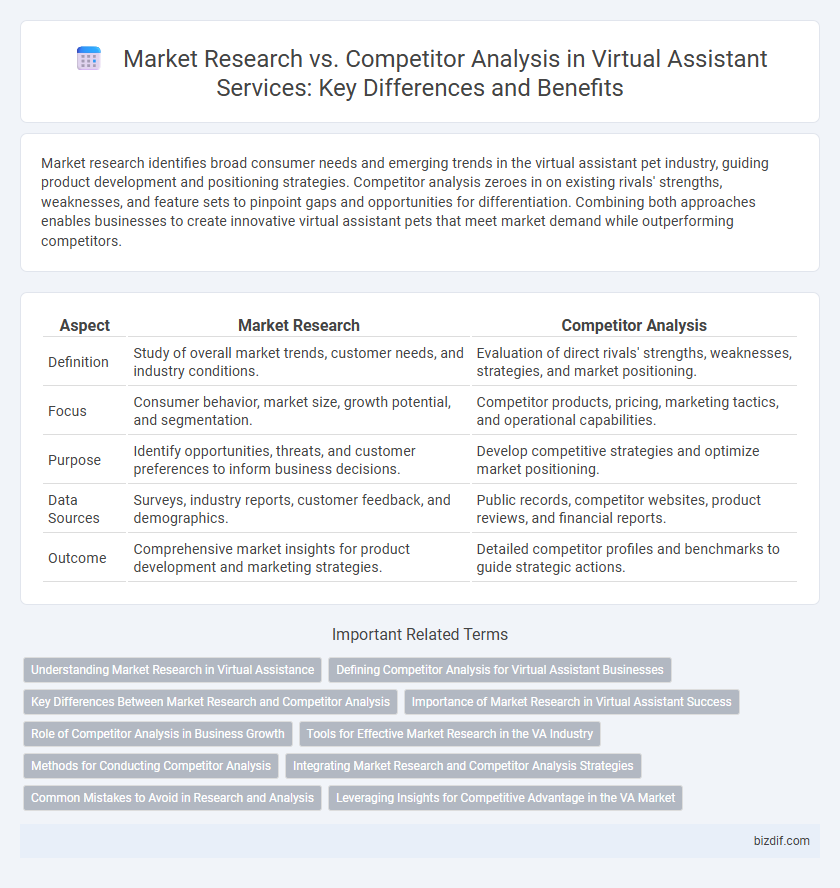Market research identifies broad consumer needs and emerging trends in the virtual assistant pet industry, guiding product development and positioning strategies. Competitor analysis zeroes in on existing rivals' strengths, weaknesses, and feature sets to pinpoint gaps and opportunities for differentiation. Combining both approaches enables businesses to create innovative virtual assistant pets that meet market demand while outperforming competitors.
Table of Comparison
| Aspect | Market Research | Competitor Analysis |
|---|---|---|
| Definition | Study of overall market trends, customer needs, and industry conditions. | Evaluation of direct rivals' strengths, weaknesses, strategies, and market positioning. |
| Focus | Consumer behavior, market size, growth potential, and segmentation. | Competitor products, pricing, marketing tactics, and operational capabilities. |
| Purpose | Identify opportunities, threats, and customer preferences to inform business decisions. | Develop competitive strategies and optimize market positioning. |
| Data Sources | Surveys, industry reports, customer feedback, and demographics. | Public records, competitor websites, product reviews, and financial reports. |
| Outcome | Comprehensive market insights for product development and marketing strategies. | Detailed competitor profiles and benchmarks to guide strategic actions. |
Understanding Market Research in Virtual Assistance
Market research in virtual assistance involves gathering and analyzing data on customer needs, preferences, and industry trends to tailor services effectively. It focuses on identifying target demographics, assessing demand for specific virtual assistant skills, and evaluating potential growth opportunities. This comprehensive understanding helps virtual assistants deliver personalized solutions that align with market expectations and enhance client satisfaction.
Defining Competitor Analysis for Virtual Assistant Businesses
Defining competitor analysis for virtual assistant businesses involves systematically identifying and evaluating direct and indirect competitors to understand their service offerings, pricing strategies, and unique selling propositions. This process enables virtual assistant firms to pinpoint market gaps, benchmark performance, and develop targeted marketing tactics that enhance their competitive edge. Effective competitor analysis integrates data on client reviews, technology adoption, and niche specialization to tailor business strategies and improve service delivery.
Key Differences Between Market Research and Competitor Analysis
Market research focuses on understanding overall market trends, customer behavior, and demand patterns to identify opportunities and risks, while competitor analysis zeroes in on the strengths, weaknesses, strategies, and market positioning of direct and indirect competitors. Market research provides broad insights into industry landscape and target audience, whereas competitor analysis delivers detailed evaluations of competitor tactics and performance metrics. Both are crucial for strategic decision-making but serve distinct purposes in business intelligence and growth planning.
Importance of Market Research in Virtual Assistant Success
Market research provides vital insights into customer needs, preferences, and emerging trends essential for developing a competitive virtual assistant. Understanding target demographics and market demand allows companies to tailor features, improve user experience, and identify growth opportunities. Effective market research directly influences product innovation, positioning, and long-term success in the virtual assistant industry.
Role of Competitor Analysis in Business Growth
Competitor analysis plays a crucial role in business growth by identifying market trends, strengths, and weaknesses of key players, enabling companies to develop effective strategies. This process helps virtual assistant providers understand customer preferences, pricing models, and feature gaps, leading to improved product offerings. Leveraging competitor insights fosters innovation, enhances customer satisfaction, and drives sustainable competitive advantages in the virtual assistant market.
Tools for Effective Market Research in the VA Industry
Market research tools like SurveyMonkey, Google Analytics, and SEMrush enable virtual assistants to gather comprehensive data on customer preferences, industry trends, and market demand. Competitor analysis platforms such as SpyFu and Ahrefs offer valuable insights into competitor strategies, keywords, and online presence, allowing virtual assistants to refine their service offerings effectively. Leveraging these specialized tools enhances decision-making and drives strategic growth within the virtual assistant industry.
Methods for Conducting Competitor Analysis
Competitor analysis methods include SWOT analysis, benchmarking, and digital footprint evaluation to assess strengths, weaknesses, and market positioning of rivals. Utilizing tools like SEMrush or Ahrefs enables detailed insights into competitors' keyword strategies, backlink profiles, and traffic sources. Social media monitoring and customer feedback analysis provide qualitative data on competitor engagement and brand perception, enhancing overall market intelligence.
Integrating Market Research and Competitor Analysis Strategies
Integrating market research and competitor analysis strategies enhances the effectiveness of virtual assistant development by providing comprehensive insights into consumer behavior and competitive landscape. Market research identifies target audience needs and emerging trends, while competitor analysis reveals strengths and weaknesses of existing solutions, enabling tailored feature innovation. Combining these approaches drives data-driven decision-making, resulting in more user-centric virtual assistant interfaces and improved market positioning.
Common Mistakes to Avoid in Research and Analysis
Common mistakes in market research and competitor analysis include relying on outdated data, which undermines the accuracy of insights, and failing to define clear research objectives, leading to irrelevant or incomplete findings. Another frequent error is neglecting qualitative data, resulting in a lack of understanding of customer motivations and competitor strategies. Avoiding these pitfalls ensures more reliable, actionable intelligence for strategic decision-making.
Leveraging Insights for Competitive Advantage in the VA Market
Market research in the virtual assistant sector involves analyzing broad consumer trends, user behavior, and emerging technology demands to identify growth opportunities. Competitor analysis hones in on evaluating direct rivals' strengths, weaknesses, service offerings, and pricing strategies to pinpoint market gaps and differentiation tactics. Leveraging insights from both processes empowers virtual assistant providers to tailor innovations, optimize user experience, and establish a sustainable competitive advantage.
Market research vs Competitor analysis Infographic

 bizdif.com
bizdif.com